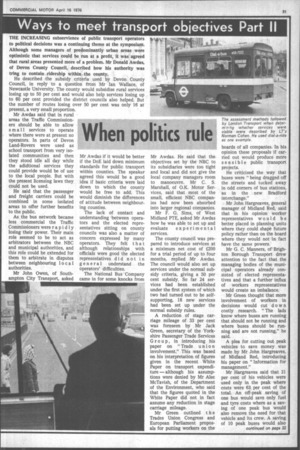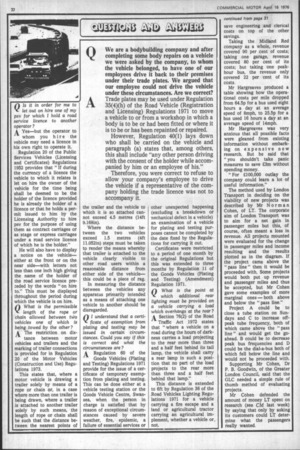When politics rule
Page 33

Page 34

If you've noticed an error in this article please click here to report it so we can fix it.
THE INCREASING subservience of public transport operators to political decisions was a continuing theme at the symposium. Although some managers of predominantly urban areas were optimistic that services could be run at a profit, it was agreed that rural areas presented more of a problem. Mr Donald Awdas, of Devon County Council, described how his authority was tring to contain ridership within the county.
He described the subsidy criteria used by Devon County Council, in reply to a question from Mr Ian Wallace, of Newcastle University. The county would subsidise rural services losing up to 50 per cent and would also help services losing up to 60 per cent provided the district councils also helped. But the number of routes losing over 50 per cent was only 16 at present, a very small proportion.
Mr Awdas said that in rural areas the Traffic Commissioners should be able to allow s m a 11 services to operate where there were at present no operators. In parts of Devon Land-Rovers were used as school transport from very isolated communities and then they stood idle all day while the adidtional services they could provide would be of use to the local people. But with the present licensing laws they could not be used.
He said that the passenger and freight carriers could be combined in some isolated areas to offer further benefits to the public.
As the bus network became less commercial the Traffic Commissioners were rapidly losing their power. Their main role seemed to be to act as arbitrators between the NBC and municipal authorities, and this role could be extended for them to arbitrate in disputes between neighbouring local authorities.
Mr John Owen, of Southampton City Transport, asked Mr Awdas if it would be better if the DoE laid down minimum standards for public transport within counties. The speaker agreed this would be a good idea if basic criteria were laid down to which the county would be free to add. This would diminish the differences of attitude between neighbouring counties.
The lack of contact and understanding between operators and the elected representatives sitting on county councils was also a matter of concern expressed by many operators. They felt that although relationships with officials were good the elected representatives did not in general understand the operators' difficulties.
The National Bus Company came in for some knocks from Mr Awdas. He said that the objectives set by the NBC to its subsidiaries were too tight and local and did not give the local company managers room to manoeuvre. Mr C. S. Marshall, of O.K. Motor Services, said that most of the small, efficient NBC companies had now been absorbed into larger regional companies.
Mr F. G. Sims, of West Midland PTE, asked Mr Awdas how he was able to set up and evaluate experimental services.
The county council was prepared to introduce services at a miximum net cost of £200 for a trial period of up to four months, replied Mr Awdas. The council would also set up services under the normal subsidy criteria, giving a 50 per cent subsidy. So far 24 services had been established under the first system of which two had turned out to be selfsupporting, 18 new services had been set up under the normal subsidy rules.
A reduction of stage carriage mileage of 33 per cent was foreseen by Mr Jack Green, secretary of the Yorkshire Passenger Trade Services Group, in introducing his paper on "Trade union involvement." This was based on his interpretation of figures given in the recent White Paper on transport expenditure — although his assumptions were denied by Mr Alec McTavish, of the Department of the Environment, who said that the figures quoted in the White Paper did not in fact assume any reduction in stage carriage mileage.
Mr Green outlined t h e Trades Union Congress and European Parliament proposals for putting workers on the boards of all companies. In his opinion these proposals if carried out would produce more sensible public transport projects.
He criticised the way that buses were "being dragged off the streets and tucked away in odd corners of bus stations, as in the new Bradford interchange."
Mr John Hargreaves, general manager of Midland Red, said that in his opinion worker representatives would be better placed in planning units where they could shape future policy rather than on the board where they would not in fact have the same powers.
Mr G. C. Manners, of Brighton Borough Transport drew attention to the fact that the managing bodies of the municipal operators already consisted of elected representatives and that a further influx of workers representatives would create an imbalance.
Mr Green thought that more involvement of workers in decisions would cut down costly research. "The lads know where buses are running that should not be running and where buses should be running and are not running," he said.
A plea for cutting out peak vehicles to save money was made by Mr John Hargreaves, of Midland Red, introducing his paper on "Information for management."
Mr Hargreaves said that 21 per cent of his vehicles were used only in the peak where costs were 63 per cent of the total. An off-peak saving of one bus would save only fuel and tyre costs where as a saving of one peak bus would also remove the need for that vehicle and its crew. A saving of 10 peak buses would also save engineering and clerical costs on top of the other savings.
Taking the Midland Red company as a whole, revenue covered 90 per cent of costs; taking one garage, revenue covered 80 per cent of its costs; but taking one peakhour bus, the revenue only covered 22 per cent of its costs.
Mr Hargreaves produced a table showing how the operational costs per mile dropped from 64.5p for a bus used eight hours a day at an average speed of 8mph, to 25.5p for a bus used 16 hours a day at an average speed of 14mph.
Mr Hargreaves was very anxious that all possible facts were gleaned from existing information without embarking on expensive new research. But he said that "you shouldn't take panic measures to save £.3m without spending money.
"For E100,000 outlay the company could learn a lot of useful information."
The method used by London Transport in deciding on the viability of new projects was described by Mr Norman Cohen, of LT. The corporate aim of London Transport was to aim for a net gain in passenger miles but this, of course, often meant a loss in revenue. All projects mounted were evaluated for the change in passenger miles and income resulting and the results plotted as in the diagram. If the project came above the "pass line" then it would be proceeded with. Some projects would both put up revenue and passenger miles and thus be accepted, but Mr Cohen gave some examples of more marginal ones — both above and below the "pass line."
Project A could be to close a tube station on Sundays and C to increase offpeak tube frequency, both of which came above the "pass line" and would get the goahead. B could be to decrease peak bus frequencies and D could be the dial-a-bus both of which fell below the line and would not be proceeded with.
Supporting Mr Cohen, Dr P. B. Goodwin, of the Greater London Council, said that the GLC needed a simple rule of thumb method of evaluating projects.
Mr Cohen defended the amount of money LT spent on research (see CM last week) by saying that only by asking its customers could LT determine what the passengers really wanted.




























































































